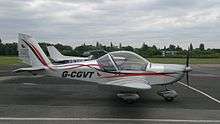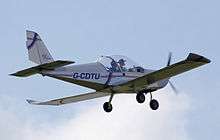Evektor SportStar
| SportStar | |
|---|---|
.jpg) | |
| SportStar | |
| Role | Light Sport Aircraft |
| National origin | Czech Republic |
| Manufacturer | Evektor-Aerotechnik |
| Variants | Evektor EPOS |



The SportStar and EuroStar are a family of a two-seat, light sport aircraft (LSA), manufactured by Evektor-Aerotechnik of the Czech Republic and powered by a Rotax 912ULS, 100 horsepower (75 kW) engine.[1][2]
The SportStar was the first approved special light-sport aircraft (S-LSA) and was named "S-LSA Aircraft of the Year" by AeroNews Network.[1]
Design and development
The SportStar is an all-metal design made from anodized, corrosion-proofed aluminum. The airframe uses a pop-riveted and bonded construction, which the company claims will improve fatigue characteristics and result in a longer service life. The company also claims this construction technique results in better crashworthiness, the elimination of rivet zippering in an accident and quieter in-flight noise levels due to the elimination of oil-canning and flexing.[3]
The SportStar was designed for towing sailplanes up to 1544 lbs (700 kg) gross weight and for towing banners up to 1479 sq ft (140 m2).[4]
Variants
- EuroStar SL
- Model for the European ultralight category, with a gross weight of 1,041 lb (472 kg)[2][5]
- EuroStar SL+
- Version of the EuroStar SL with a new wing and integral fuel tanks, bigger baggage compartment and lower empty weight by 8 kg (18 lb).[6]
- EuroStar SLW
- Model for the European ultralight category, with a gross weight of 1,041 lb (472 kg). It combines the EuroStar fuselage with the wing and stabilizer from the Harmony.[6][7]
- Harmony
- Model for the US LSA market, based on the Harmony airframe, with enlarged ailerons and rudder to improve crosswind capabilities, an improved wing, winglets and tail, wider and longer cockpit, as well as refined wheel pants and other fairings.[2][6]
- SportStar
- Initial model
- SportStar SL
- Improved model
- SportStar Max
- Version for the US LSA market with a gross weight of 1,320 lb (599 kg)[1][2]
- SportStar RTC
- SportStar RTC was developed to meet EASA VLA certification and intended for use in flight training.[8]
- Evektor EPOS
- Electric aircraft version, using the SportStar RTC fuselage and a new wing design.[6]
Specifications (SportStar MAX)
Data from Evektor website[9]
General characteristics
- Crew: one
- Capacity: one passenger
- Length: 17 ft 7.5 in (5.98 m)
- Wingspan: 28 ft 5 in (8.65 m)
- Height: 8 ft 2 in (2.48 m)
- Wing area: ft² (m²)
- Empty weight: 668 lb (308 kg)
- Useful load: 640 lb (292 kg)
- Loaded weight: 1320 lb (600 kg)
- Max. takeoff weight: 1320 lb (600 kg)
- Powerplant: 1 × Rotax 912ULS, ground adjustable propeller, 100 hp (75 kW)
- Propellers: Klassic 1700/3/R, composite, propeller, 1 per engine
- Propeller diameter: 5 ft 6 in (1.7 m)
Performance
- Never exceed speed: 146 knots (270 km/h)
- Maximum speed: 115 knots (213 km/h)
- Cruise speed: 110 knots (204 km/h)
- Stall speed: 40 knots (74 km/h)
- Range: 700 nm (1300 km)
- Service ceiling: 15,500 ft (4720 m)
- Rate of climb: 1020 ft/min (5.2 m/s)
- Wing loading: lb/ft² (kg/m²)
- Power/mass: 12.68 lb/hp (0.13 W/kg)
References
| Wikimedia Commons has media related to Aerotechnik EV-97 Eurostar. |
- 1 2 3 Evektor, spol. s r.o. (n.d.). "SportStar Max Overview". Retrieved 4 November 2011.
- 1 2 3 4 Bayerl, Robby; Martin Berkemeier; et al: World Directory of Leisure Aviation 2011-12, pages 47-48. WDLA UK, Lancaster UK, 2011. ISSN 1368-485X
- ↑ Evektor-Aerotechnik. "Advanced Airframe with Long Service Life". Retrieved 5 November 2011.
- ↑ Evektor-Aerotechnik (n.d.). "Glider Towing". Retrieved 4 November 2011.
- ↑ Evektor (n.d.). "EuroStar SL". Retrieved 4 November 2011.
- 1 2 3 4 Tacke, Willi; Marino Boric; et al: World Directory of Light Aviation 2015-16, pages 48-50. Flying Pages Europe SARL, 2015. ISSN 1368-485X
- ↑ Evektor (n.d.). "EuroStar SLW". Archived from the original on 31 October 2011. Retrieved 4 November 2011.
- ↑ "SportStar RTC". evektor.com. Retrieved 5 October 2015.
- ↑ Evektor, spol. s r.o. (2011). "Technical Data". Archived from the original on 2011-08-22. Retrieved 2011-11-05.